
 |
I have recently found quite a bit of information on the early Lenz or Lentz family thanks to the research of the late Walter Lee Sheppard, Jr. I have tried to incorporate this information to my own research. My research is good for Generation 7 and higher. As a link between Generation 7 and the earlier Generations of Lentz or Lenz, I have used a book written in 1877 by George Bates about Philadelphia butchers. Unfortunately, that book didn't identify "old daddy Lentz" by first name. That would have helped. I have concluded that he was the George Lentz of Generation Five born 1770. I have also tried to link the families as best I can at the time by name, occupation and residence.
On Rootsweb.com, I have found two additional generations. The earliest Lentz in this line was Hans, b. about 1556. He married Gertraud Glauner on 4 Feb 1578/9. They had Caspar Lentz born 29 Jun 1598. He married Margaretha Hohlmayer daughter of George Hohlmayer on 16 May 1620. He died in Schnait on 7 Jan 1647/8. This couple had Georg Lentz who was born 23 Apr 1622 in Schnait and died 24 JUL 1663 (see below).
 |
He was a surgeon and married a surgeon's daughter. I suppose there are some similarities between surgeon and the later Lentz butchers. Beutelsbach, Schnait and Gross Heppach are located about 8 miles East of Stuttgard and 6 miles West of Schorndorf. A view of GoogleEarth shows some of the area on the slopes to the (Rems?) River are still in agricultural use in Beutelsbach. The map appears to be a railroad map, so doesn't show roads in Beutelsbach.
 |
Anna Maria Vetterlin's father was from Snaith.
According to the Rootsweb.com WorldConnect Project, this couple had another son named Christoph, born 14 Dec 1696 in Beutelsbach. He had a son named Christoper Lentz born 22 Jun 1729 in Beutelsbach. He married Barbara Bergenthaler in Germantown on 25 Dec 1759. He died on 27 Jul 1794 in Montgomery Co., Pennsylvania. He would be the first cousin of my immigrant ancestor Johann Jacob.
I also have some information on Chistoph from Don Yoder's Pennsylvania German Immigrants. He was a mason and stonecutter. "Went to Pennsylvania, 3-25-1746, on account of discontent, and before he got there, died." It is unclear whether he emigrated with his wife and four children. Obviously one (Christopher) appears to have emigrated. Another noted travelling on the Ann Galley was Christian Lenz of Beutelsbach, b. 1-4-1699. He died before he got to Pennsylvania. He had a wife Anna Maria and 4 children: Christian, b. 1728;, Johann Jacob, b. 1729; Maria Barbara, b. 1736 and Anna Maria, b 1738. The book does not say if they all emigrated.
Finally the Yoder book mentions "...Henry Lentz, with wife and four children, age 43, from Beutelspach, farmer, 5-1/2 feet tall, dark brown hair, landed at Philadelphia September 19, 1804, from the ship Margaret".
 |
Anna Christina Jetzel's (or Jessel's) father and grandfather were ropemakers. Her mother's father was a vinedresser and member of town council. Apparently the area was a winegrowing region. According to www.edenwines.co.uk, currently, there are 4 wine-producing areas of Württemberg. One of these, "Remstal-Stuttgart, on steep muschelkalk slopes around Stetten, Beutelsbach and Schnaidt develop Trollinger, Sylvaner and Riesling".
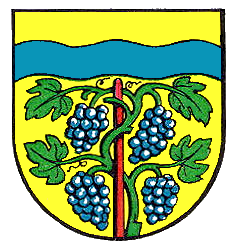 |
The image above right is the coat of arms of Grossheppach.
According to Sheppard,
"Johann Jacob Lenz (variously Lentz and Lens), son of Hans Jacob, was born in Beutelsbach, Württemberg, 7 janary 1727. In the local records he is referred to as "bachbecken" (baker on the brook) through the year 1758 (the year of the baptism of his eldest surviving son). After this date he appears either as "weingärtner" (vinedresser), or with both descriptions. He married four times, his first three wives each dying at or shortly after the birth of a child. His fourth wife, whom he married as Gross Hepach on 14 June 1757, was Anna Maria Löffler, daughter of Johann Melchior Löffler, born 17 May 1735 in Gross Hepach. She was the mother of his three surviving sons."
Back in Germany Anna Maria's father was a vinedresser as was her grandfather. Her greatgrandfather was a baker and soldier. He served as a soldier in Hohenasperg and died in Hungary.
Johann Jacob emigrated on the Minerva on 13 October 1769. He was either joined by his wife and children or they sailed soon after.
Anna Maria, also known as Mary, married Johan Christopher Keppler 15 Jul 1778 at St. Michael and Zion Lutheran Church, Philadelphia. They lived in 1784 in Plumstead Township. Johan Christopher probably died before 1790 as Mary Kepler was living in Northern Liberties in 1790 as head of household. This couple had a daughter, Elizabeth and a son Johann who probably died young. In 1817 she is listed as a widow and doctoress living at 365 N. Third St., Northern Liberties. According to Sheppard, Mary's will was proved 14 October 1818. He cites the following notation on that will: "I John Lentz am Perfectly Sattisfied that all my Mother estate shall go to my Sister Elizabeth Shinnick." If this John is the same as below, then there is quite a bit of confusion as to who he is. Is he a son or a grandson? See "Who Was John Lentz?" below.
I will enter some relevant information from an article from Walter Lee Sheppard, Jr. from the National Genealogical Society Quarterly XLVIII, Mar, 1961, p. 32:
 |
Again, we see the troublesome John Lentz showing up. I assume that John mentioned is different than the son Johann. I wouldn't expect a payment in a will to a 9 year old. Below is the unexplained death of 'Godfrey' from a 7-29-1799 Philadelphia newspaper
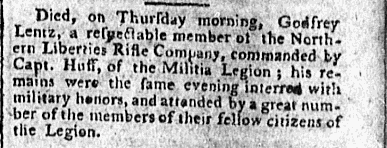 |
On September 5th the same year was published:
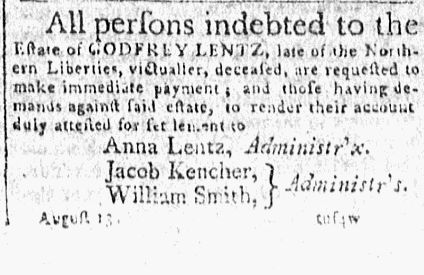 |
As a point of reference, on December 26, 1799, there was a National Funeral Procession for George Washington in Philadelphia. The largest church in the area at the time was the new Zion Lutheran Church. This building was used for the funeral service. This is the Church where some of the Lentz family had their baptims, marriages and funerals (St. Michael's and Zion). Finally on 4 April 1804, we see this interesting description of Godfrey's house, business, and how they were situated. According to Sheppard (see above) Jacob Goetz marries the widow Ann or Anna in 1800. I wonder why this property was ordered to be sold.
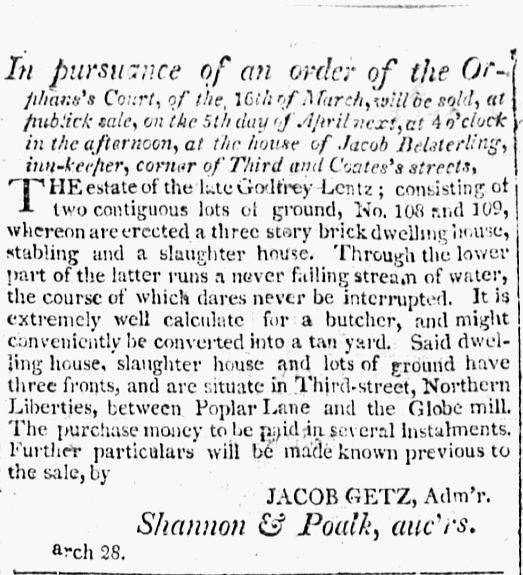 |
 |
 |
We see to right that Jacob was part of the first fire company of Northern Liberties. According to the History of Philadelphia, "Friendship Fire Company , Northern Liberties, founded Aug. 18, 1796; located at the Commissioner's Hall , Second and Coates Streets, Northern Liberties". This excerpt is from p. 1888, History of Philadelphia, 1609-1884 By John Thomas Scharf, Thompson Westcott, Published 1884 L. H. Everts & co. Jacob certainly had business interests to protect as well as his dwelling. There were many wood-framed buildings in the area - probably built close together. During this time Northern Liberties was about the 10th most populous city in the Country.
According to the research of Sheppard, Jacob was listed
between 1791 and 1828 in the Philadelphia City Directories:
 |
Again I rely on the excellent research found in Sheppard's Footnote 10 in his 1961 NGSQ aritcle. I am surprised that Jacob was able to amass so much money as he was a first generation immigrant.
 |
The image on the right is from a watercolor painted by Benjamin Evans as he believed the are looked in 1806. It was painted in 1887. At the time the Sheep from the poster below were being sold by Lentz, this market area would have taken up 2 blocks. However, in 1806, the Market was smaller. The full scene shows Patterson's Church. The building in the middle of Second Street is a brick market shed with a weathervane. The trunks of the trees are protected by green boxes. Evans painted a variation on the same view in 1883.
Here is an ad for selling property where George Lentz once lived. Fortunately, whoever wrote the ad included book and page numbers from the Registry.
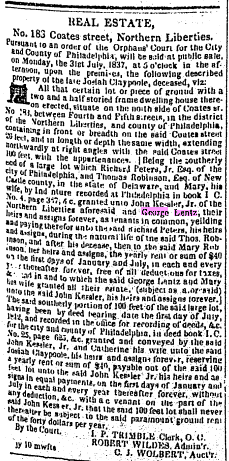 |
According to Sheppard, "It is noted that in the 6th ward of Northern Liberties, in the 1830 census, there were a Josept Lents (one male 20-30, one female 20-30), and a John Lentz (a male 30-40 with 3 male children, and one female 40-50, and one female 20-30, with two younger females)..." This could put these 2 born around 1800 - John before and "Jopept" after.
 |
The 1798 Direct Tax list for
Philadelphia Northern Liberties Ward, West Philadelphia lists
several different Lentz families. I extracted the above Lentz
names from the complete list at: http://www.math.udel.edu/~rstevens/datasets/nlibw_98.dbf
One, George Lentz was taxed for a slaughterhouse. His house was
at Coats and New 4th, and his slaughterhouse at Oak Street. Oak
Street may be seen to the bottom right of the 1802 map. The
second house on the image to the right would be at Coats and 4th.
This image was taken from the David Rumsey Map Collection.
Clicking on the image to the right will bring up a larger image
showing the Globe Mill mentioned below on the Coheeksink Creek.
The outline of the Market on Second Street corresponds to the
water color painting below of 1806. Note that in the 1845 map
below, the market area covered 2 blocks.
There was a George Lentz living next to a John Lentz in the 1820 Census. It is possible that "Old Daddy" Lentz was George. There was also a Jacob Lentz living in the same ward at the time.
On page 1 of an 1877 book concerning deceased butchers by George Bates, we find out more about Old Daddy Lentz. Later, on page 6 is more information concerning the family.
Old Lentz was the father of John Lentz and Joseph Lentz. John was the father of Jake Lentz, deceased, and also of William Lentz, deceased. Old Lentz had a barn up Milldam lane, below Brown Street and I remember a circumstance occurring of my being a juryman at the inquest held on a tramp who was drowned in a ditch near the barn, and his pig-tail tobacco was near him, of which it was supposed he was in the act of taking a chew and missed his step, it being a dark, rainy night.
In the above description, there was a correction changing Brown Street to Broad Street at the end of the book. However, it appears from the image to the right that Milldam is closer to Brown Street. This would be a logical place for Old Lentz to have a barn as it is not too far from the Market Place on Second Street near the intersection of Brown Street. Milldam was on the Cohecksink Creek. There are many other spellings for this creek. Previousy, Milldam was the site of the Globe Mill. When I take a second look at this, another possibility is that the barn was the same as the slaughterhouse listed in the 1798 tax list. This was on Oak Street by the Delaware River.
 |
Here is another interesting image from the book:
 |
It appears that Old Lentz was a prominent figure in the Philadelphia community of butchers. Further in the book, the writer mentions that, "William Shunk, deceased and Joseph Shunk deceased and little Johnny Beers deceased, all served their apprenticeship with Old Lentz. Old John Pray bought the beef tounges of old Lentz".
Here is an aritcle that appears to support my assertion that "Old Daddy Lentz" was the above George Lentz. In this contemporary artice the above Shunk is called Strunk.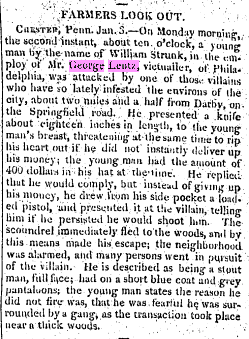 |
Some further information from Sheppard:
George Lentz, Admin 1849, No. 363 (Docket P-508), administration to Henrietta, the widow, 30 Aug. 1849. The inventory included a chopping block, suggestive since our man was a butcher, but residence was Kensington, next ara over from Northern Liberties. His death record was found in the Board of Health records as: died 25 Aug. 1849 of typhoid dysintery aged 37 (sic) years.
 |
I know from my own Lentz research that the family moved to Kensington, so this information reaffirmed the work I had done. As Sheppard shows later, the son George Lentz died before the father in 1841 in Kensington.
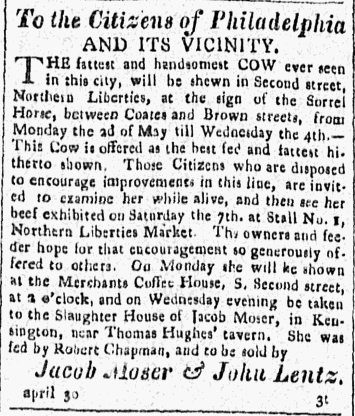 |
William Lentz was listed as a butcher in the 1859 Philadelphia directory. William lived at 914 Nectarine Street. Both Jacob and William are listed in the 1859 Philadelphia Directory. Jacob's listing, "vict, Montgomery avenue bel F rd (K)
John Lentz is a focal point to connecting my Lentz Ancestors to the ealier immigrant family identified by the genealogist Walter Sheppard. Sheppard was a bit puzzled by this person. He noted his appearance in the Philadelphia directories. We find in the City directories in the same period as George Lentz and Jacob Lentz appear, a John Lentz, cabinet maker, at Coates and 3rd, the
The appearance of the name of John Lentz can not be passed over in the same area. A John also appears in the 1830 census of the 6th ward of Northern Liberties: 1 male under 5: 1 male 5-10; 1 male 15-20; 1 male 30-40; 1 female under 5: 1 female 15-20; 1 female 20-30; 1 female 40-50. There is nothing to indicate whether the John of Northern Liberties, who certainly lives in the same area, is another child, not previously seen, of Johann Jacob and Anna Maria, or a member of the Henry Lentz family. If the former, he is more tha 10 years older than indicated in the census. Note the presence of one female, 40-50. Perhaps the male entry belongs in the same column.However, there was at least one possibility that Walter Sheppard did not consider.
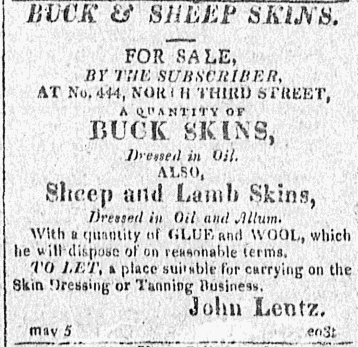 |
According to George Bates' book, "Philip Miller, deceased, was the father-in-law of Jacob and William Lentz, both deceased, and step-son-in-law of old daddy Lentz." The author had more than a passing knowledge of Miller as we find on p.6 of his book, "Charles P. Bates, deceased, served his time with Philip Miller. He was my brother..." So It appears that John died fairly young and Philip Miller married his wife. This solves some problems such as the age of John in the census returns. However, it raises other questions. I estimate that he was born around 1790 as George, who I suppose was his father would have been 20 at that time. This makes him young in 1805, assuming he was the one to place the ad of the lost horse. He would have been a teenager at the time. This could also mean the address could have been at his father's or that he was boarding nearby. Another discrepancy is that Sheppard has this John as a cabinet maker. However, from the ads he appears to be in the butchering trade. From the 1815 ad, it appears that John was trying to get out of the animal trade. Could this explain the listings as a cabinet maker?
Here are two obituaries which correlate what the Bates book says showing the relationship between the Miller and Lentz families. The Mary A. in the obituary is the widow of Jacob Lentz below. It appears that Eliza could have first been the wife of John.
 |
In summary my conclusion is that John Lentz was the son of George above. Perhaps his mother died or was otherwise out of the picture. Perhaps George's mother raised him. There is a payment to him out of Godfrey Lentz' will. This was in 1799, so John would have only been around 9 if I am correct. However, this could have been for his child support. He refers to Mary (Löffler Lentz) Keppler who I have as his grandmother as his mother. However, she may have acted as his mother. He lost a Mare in 1805 while living at 3rd Street about Coates Cemetery. This cemetery was subsequently moved but was originally at the SE corner of 3rd and Brown. He appears to have been involved in the butcher business and then perhaps was a cabinet maker. He had 2 children at least probably by a woman named Eliza (unknown last name). She later married Philip Miller. They together raised the family.
 |
Having said that, there is the possibility that there were 2 Johns during this period. The one I have not identified could have been an older cabinet maker. I do not know who his parents would be. He may have even been from a different branch of the family. Perhaps he was also the one that lost the horse and that payment was made to in the will of Godfrey Lentz. The other John would be as I have above - the son of George Lentz. He would have been born around 1790 and probably went into the business of selling livestock and/or tanning.
Philip Miller's house in 1861 was at the intersection of 2
major Streets. He belonged to the Independent Order of Odd
Fellows. This was a fraternal organization with roots in
England.
By 1841, this George and perhaps more of the Lentz family were in Kensington. According to Sheppherd, "George Lentz, will, (also Kensington) dealer, Will Book 15 page 220, dated __ May 1841 sworn by Samuel Grubb, witness 1 Nov. 1841, oath of widow Christiann, testatrix 2 Nov. 1841, which left all to widow while a widow, and until youngest child comes of age. Four children: John, Elizabeth, Catharine and William. Property is to be sold if she dies before the children come of age. This estate continued many years, with letter to William B. lentz 2 Mar. 1893 and to the Commonwealth Title Ins. Co. 24 Oct. 1895. The death record was again found in the Public Health Records: 24 Oct. 1841 aged 43, of a "remitting fever.""
 |
It appears from the stone that Charles was married. The Photos of the two gravestones were taken by Pamela Whitaker.


|
Jacob was listed as a victualler in the 1850 census. Also living with the family at the time was 13 year old Irish born Sarah McWhurter.
Jacob Lentz believed to be George Lentz's father lived on Montgomery Street at the same time as he was listed as a vict. [victualler]. This seems likely as George's son (below) was named Jacob and he lived at East Montgomery Street. The poster shown to the right from 1851 has Jacob Lentz's name written on it on the bottom with a weight of 175#. This poster was found in the William Lentz (b. 1892) family belongings. The top is cut off but says "Liberty and Kensington against the world". The original poster is about 18" by 15".
The map to the right shows where the Lentz family lived at the time of Jacob's obitury notice in 1869. The Palmer Cemetery is just a block and a half away. It is in the plot of land to the left of the "G" in Gaul Street. In 1875, Mary A. Lentz was living at 1865 Montgomery Road (now Ave.). This is a block and a half North of E. Montgomery Ave. on the East side of the present Frankford Avenue.
 |
The death notice to the right was published on 6 February 1869 in the Philadelphia Enquirer. The Palmer Cemetery Charitable Grounds are located at Palmer and Belgrade Streets. Anthony Palmer was the one who laid out Kensington and provided a free place to bury the inhabitants.
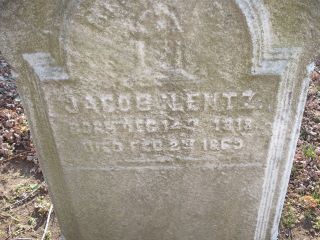
 |
George was 29 in 1870 and his wife Mary was 23. His house at that time was worth $2,000 and his personal belongings worth $1,000. He and Mary A. (--?--) appeared on the census of 4 Jun 1870 at Philadelphia, PA.
The Philadelphia Inquirer published his death notice on the 18th and 20 of February 1888.
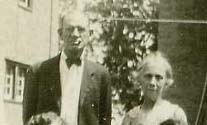 |
Description of the expanded picture right
TOP - Uncle Stanley, grandfather Lentz, Grandmother Lentz
MIDDLE - Aunt Agnes, Cousin Hazel, Gladys' Mom
BOTTOM - Cousin Doris, Rob, Cousin Rob Poole, Muriel, Gladys

|
According to Florence Grehlinger:
That is a picture of me, about age seven, probably around 1942. The picture was taken in a little park across the street from the house in Pitman, NJ where I grew up. The other two kids are my nieces, they are Annie Lentz's great grandchildren. The oldest of the two is Peggy (Morgan) Reigle and the younger is Joan (Morgan) Parker. They are my sister Elva's children. Since I am three years older than Peggy, I guess they are 4 and 3 years old. I really don't know how Annie Lentz came to little old Pitman, this is the only time I can ever remember seeing her.
 |